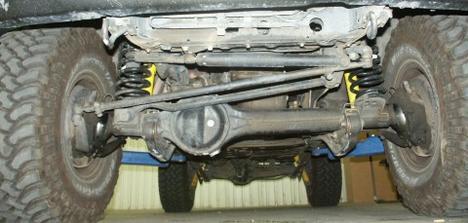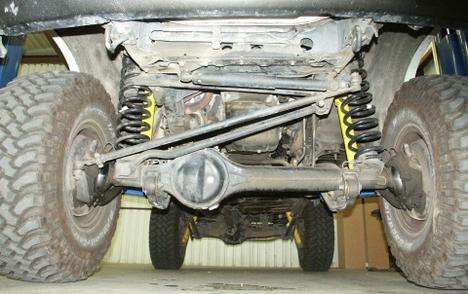FJ-80 Bumpsteer Question: I own a '93 FJ80. It has a 6" body & a 6" suspension riding on 42" Super Swampers TSL'S. The lift was done by Toyota of Japan. The previous owner ran 35" BF Goodrich. When I installed the 42's, bumpsteer became a problem. What causes bumpsteer and how can it be corrected?
Tomas / Okinawa, Japan
Answer:
Bumpsteer is caused by a change in the relative position between the steering box and the front axle. The higher the steering box is above the drag link mount on the axle, the more bumpsteer you will see. Lifting a truck without addressing the angle of the drag link is a common way of introducing bumpsteer, and the higher you lift, the greater the drag link angle becomes, and the more likely you are to notice the problem. Ideally, the drag link should be level, but this is rarely practical.
Below are two photos of an FJ-80. The first photo shows a truck with a 3" lift (OME J springs). The second photo shows the same truck lifted up an additional 4 inches using a shop lift. Notice the difference in the drag link angle.


There are several other items that can make a small bumpsteer problem worse. Addressing these other items may help reduce the effects. First make sure all the steering components are tight and in good condition. Loose, broken and worn-out parts aggravate the condition. Check each tie rod end for play in the joint. Replace any ends that have noticeable play in them. Check jam nuts and/or clamps used to hold the tie rod and drag link. Check the mounting of the steering box and tighten if it has become loose. Having one good steering stabilizer can help reduce excess vibrations. Old Man Emu makes a good quality after-market steering stabilizer for 80 series rigs. I would recommend this or other quality stabilizer be used on any lifted application. These are available through most ARB dealers around the world. On coil/link setups like your FJ-80 it's also important to check the condition of the panhard rod link ends for looseness or damage. The panhard rod is the link that keeps the axle located (left to right) under your truck. Take your truck to an alignment shop and have the castor checked. Castor must be within the factory spec or the front end will wander left and right. The castor is not adjustable on your truck so you may need to consider installing custom lower link arms, castor correction bushings or relocating the link mounts on the axle to correct the castor.
On many trucks after-market drop pitman arms can help reduce the the angle of the drag link to an acceptable level. Unfortunately, there are not currently any vendors making such an arm for FJ-80's at this time. Lowering the front lift somewhat can have a positive effect. Also consider a stiffer front spring rate. A stiffer shock/coil setup will reduce the bumpsteer effect by slowing down the compression cycle speed.
| Toyota Questions and Answers |
Dirty Fuel in the Bottom?
Question: I have heard that it's a bad idea to run my truck when it's low on gas, something about more contamination as the gas level lowers in the tank. Is this true?
Answer: Basically no, but there are some exceptions.
In a normally operated vehicle there is no difference in the amount of impurities between a full tank or one nearly empty. Some people have literally become scared into believing that all sorts of bad things will happen if they let their tanks drop below 1/3, thus getting into the "dirty" fuel on the bottom. An understanding of how the fuel system works can help dispel unjustified fears.
A fuel tank is a lot like a bath tub. Water comes in from the top and is drained out the bottom. Contaminates come in two verities, suspended and unsuspended. Suspended particles are like dirty/soapy water. Unsuspended particles would be items like sand and the bar of soap in a tub. The unsuspended contaminates fall to the bottom of the tank (or tub in this illustration). Smaller items like the sand in the tub get washed down the drain, but larger items like the bar of soap don't go down the drain due to the size of the drain and its strainer.
Most fuel systems have a pickup strainer before the fuel filter. Particles too large to get past the strainer will stay in the tank. The strainer is generally so small that items like sand will stay in the tank and lie at the bottom for the life of the car/truck without ever interfering in the performance of the fuel system. Even after decades of use and hundreds of thousand of miles, only a small amount of sand-like material can be found in a tank and has no affect on the fuel system or engine performance.
Suspended contaminates are blocked by the fuel filter or are burned in the motor. Due to the mixing of the fuel during driving, the amount of suspended contaminates in the fuel is consistent regardless of the amount of fuel in the tank. Just like the dirty water in the bath tub. The mixing of the water causes the water to be nearly equally dirty from top to bottom.
Water contamination is generally not a problem but in extreme conditions water can decrease the potency of the fuel. Freshly refined gasoline does not mix with water. Water weighs 8 lbs per gallon and gasoline weighs 6 lbs per gallon. The natural tendency is for water to settle to the bottom, with gasoline floating to the top of the water. After refining, additives such as alcohol are added to automotive fuel to bond water molecules to fuel molecules. This allows a small quantity of water to be absorbed by the fuel without separating.
Great measures are taken to prevent water contamination in the refining and delivery of fuel. However, when the conditions are right, water can and does find its way into your fuel. You might think that once your fuel cap is on, your fuel system is closed. The truth is that the system is vented, and the water comes in through the vent in the form of humidity. As fuel is used, the gas is replaced with air through the vent system. As the air cools, water droplets condense and slip into the fuel. A partially empty tank breathes a bit each day. As a partially empty tank heats up, a small amount of air expands and escapes through the vent. As the tank cools in the evening, air returns through the vent back into the tank. The greater the day/night temperature differential, the greater the exchange of air. A vehicle parked for months at a time with a partially empty tank in the right weather conditions is going to absorb water through this daily heating and cooling. The lower the fuel level, the more air is vented each day.
Another condition that decreases the potency of fuel is time. This can be likened to opening a can of soda and letting it sit. Once it's vented to air, it begins to age and looses its bubbles. Think of the bubbles in soda as the energy in fuel. As fuel ages it looses some of its "bubbles". Typically gasoline
 can sit for up to 3 months in a sealed container and still work adequately. For storage longer than 3 months and up to 15 months, use an additive such at
Sta-Bil.
can sit for up to 3 months in a sealed container and still work adequately. For storage longer than 3 months and up to 15 months, use an additive such at
Sta-Bil.
The combined effects of fuel aging and water absorption can significantly decrease the performance of gasoline. It's a good idea to fill your tank if you're planning to store it for more than a month.
| Toyota Questions and Answers |
Question: I am going to purchase a Toyota Tacoma 4-door truck and I am deciding on whether to get the 4-wheel drive or 2-wheel with the TRD package and locking differential. My question is primarily what the locking differential will really do for me. I am leaning toward the 2-wheel drive model because of the lesser price. If I don't go off road a lot but I do want help in the snow and pulling a boat out of the water, will the locking differential help significantly?
Answer: Yes on the ramp, no go in the snow.
The Toyota electric rear locker option makes a big difference in traction and is a lot cheaper than going to full 4wd. A non-locked differential applies power to the tire with the least traction. So if you're pulling a boat up a ramp and one tire gets on a slippery section, that tire will spin and you won't get up the ramp. With a locker, both wheels are locked together and if either tire gets traction you will be able to pull up the ramp.
In the snow however, 4wd makes a huge difference. Just locking the rear end won't make a big difference in the snow. Even with the open differentials, 4wd in snow completely changes the way a truck drives. Here in California when it snows, 2wd vehicles are required to install chains on the drive wheels. Most of the time 4wd vehicles are allowed to drive without chains. This is because with 4wd you're much more likely to stay in control and be able to continue driving.
Please note that 4wd does not change braking in the snow. The ability of a good 4wd system to keep a truck going in the snow inspires confidence, but does little to help you stop in the slippery stuff.


 Your Privacy Choices
Your Privacy Choices